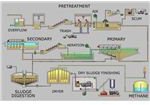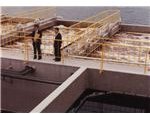Introduction to Drinking Water from Wastewater
Wastewater treatment plants have become more efficient due to government legislation regarding capacity and chemical composition post treatment. They have also improved with increasing use of microorganisms during processing of the wastewater.
The microorganisms are added after initial screening and pre-treatment of the wastewater.
This is an article on Civil Engineering and in particular on the biological treatment known as wastewater bioremediation applied to produce drinking water from wastewater.
We begin with an overview of a typical wastewater treatment plant.Overview of Wastewater Treatment Plants
The wastewater is removed from our homes and businesses using 6” clay/plastic pipes that convey liquid and solids to the main sewage pipe that runs under the middle of the road toward the wastewater treatment plant. The pipes run at an angle to assist the gravitational flow, with this being boosted on its way by pump stations. The pipes also collect runoff from hard standing features such as car-parks and drainage from the roads, which contains tar, hydrocarbons, salt, and grit.
On arrival at the treatment plant, the wastewater is screened to remove paper, tree branches, grit, and cloth that would damage the pumps in the process system.
The wastewater is then treated using up to three further processes.
1. Primary Treatment.
This involves storing the wastewater in settling tanks where metal salts are added to encourage solids to cling together through a process called flocculation, forming sludge at the base of the settling tanks
2. Secondary Treatment.
The residual effluent is pumped to aeration tanks, where air is constantly injected and microorganisms are added to break down the remaining solids.
3. Tertiary Treatment.
This next treatment removes the nitrogen through de-nitrification processing and phosphates usually by chemical precipitation from the effluent.
A typical wastewater treatment plant and process flow diagram is shown below:


This is where the effluent is normally safe enough discharge to the sea or rivers, however where drinking water is to be the end product, further processing is required and this shall be discussed in the next section.
Wastewater Bioremediation to Reuse as Drinking Water
Wastewater bioremediation for reuse as drinking water will require the aforementioned processes as well as the removal of all suspended solids, algae, fungi, and viruses. Minerals or metals such as iron, sulphur, manganese, and runoff pollutants such as fertilizers, hydrocarbons, and tar must also be removed.
Although there are natural microorganisms used in wastewater treatment, the process of bioremediation process requires further addition of various types of microorganisms known as bioremediators. Since there is an organism available to treat any organic molecule (the microorganism does this by extracting the energy from the molecule bonds), it is a very effective treatment.
However, it is essential to distinguish the types of microorganisms present as well as the organic pollutants to be removed and where they are to be located in the wastewater process. This can be carried out by specialist companies who, after taking samples, will make recommendations on the types of microorganism to use along with their best locations in the wastewater treatment processing plant.
We join a typical three phase wastewater treatment plant after the initial screening and course filtration has been carried out and major debris removed.
As we saw in the overview, the primary phase involves flocculation and is aided by the addition of metal salts to the wastewater encouraging the solid particles to clump together and settle out in the bottom of settling tanks as sludge containing organic and non-organic matter. The sludge is now subjected to anaerobic degradation. The addition of microorganisms to the natural anaerobic microbes can speed up the process of breaking down the sludge while also producing methane gas used as fuel in on-site power generation.
Flocculation and settling are essential processes used to remove the non-organic matter before the secondary treatment. Since this process relies on microorganisms, these microorganisms won’t eradicate non-organic matter.
Bioremediation - Addition of Microorganisms
The effluent now passes to secondary treatment settling tanks where it is biologically oxidized; air is injected through the effluent and the recommended microorganisms added. This process removes any remaining suspended/dissolved solids including fecal matter; secondary settling following this process removes any remaining particulates. This process also reduces the effluents Biological Oxygen Demand (BOD)
Before we leave this section we should have a look at some of the conditions needed for optimal efficiency of the microorganisms and their proliferation in the processing system
- A constant temperature
- Dissolved oxygen content
- pH
- Nutrient levels

Dedicated Team spirit and thanks to Greenko group CEO and MD Shri Chalamalasetty Sir and Shri Mahesh Koli SIr, AM Green management Shri Gautam Reddy, Shri GVS ANAND, Shri VIJAY KUMAR (Site Incharge), Shri G.B.Rao, Shri PVSN Raju, Dr. V. Sunny John, Shri V. Parmekar ,Smt .Vani Tulsi,Shri B. B.K Uma Maheswar Rao, Shri T. Govind Babu, Shri P. Rajachand, Shri B.V Rao, Shri. LVV RAO ,Shri P.Srinivaslu Promotion- EHSQL-by Dr. A.N.GIRI- 28.1 Lakhs Viewed Thanks to NFCL.
Thursday, 10 January 2013
Drinking Water from Wastewater
Subscribe to:
Post Comments (Atom)
No comments:
Post a Comment